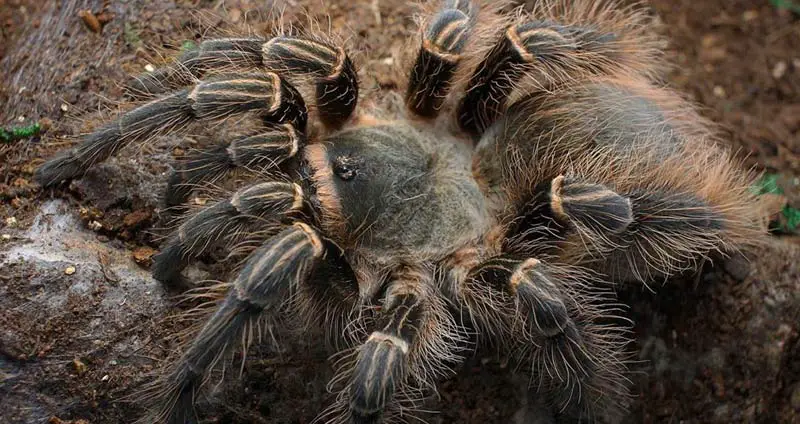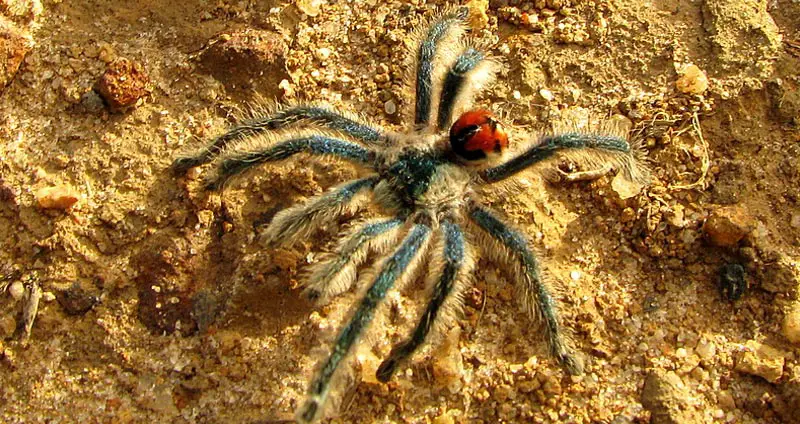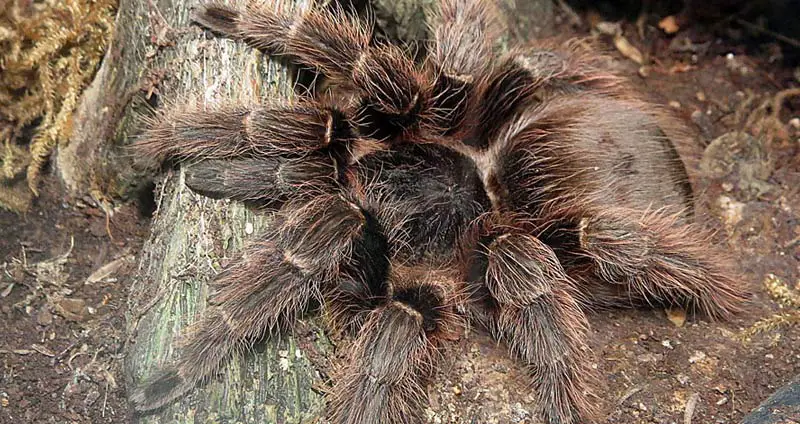There are hundreds of tarantula types, so picking the next one to bring home may be difficult. Here, we present to you Eupalaestrus campestratus, or the Pink Zebra Beauty tarantula. Its unique appearance and docile nature make it a great choice for everybody.
This care sheet will give you detailed look at this excellent tarantula species. We’ll cover its temperament, diet, and environmental needs — everything you need to know!
Table of Contents
Eupalaestrus campestratus Care Sheet
| | |
Common Name |
Pink Zebra Beauty |
Species Type |
New world terrestrial |
Natural Habitat |
Found in Paraguay where temperatures are quite extreme year-round. |
Growth Rate |
Medium growth rate, taking several years to reach maturity. |
Adult Size |
Females and males reach a legspan of about 6 inches. |
Lifespan |
Females can live up to 25 years, while males don’t often live past 6 years. |
Enclosure |
The enclosure should be wider than it is tall with an emphasis on floor space. 6 inches of substrate should line the floor of the enclosure, and a hide and water dish need to be present. |
Temp/Humidity |
75°F to 80°F with about 70% humidity. |
Diet |
A great eater that always puts on a show. Can eat several adult crickets per week, or around 2 dubia roaches. |
Temperament |
Very docile. Spends most of its time on display, just relaxing. Can sometimes be skittish. |
Experience Level |
Beginner – A very friendly and easy to care for tarantula. Excellent for beginners. |
Average Cost |
Slings ~ $40, Males ~ $60, Females ~ $75+ |
Eupalaestrus campestratus Appearance
Although the Pink Zebra Beauty is relatively new to the market, many people seek it out. The beautiful appearance has a hand in that.
It has been named Pink Zebra Beauty for a good reason. It has a dark-brown body with a hint of the color pink. As for Zebra, it’s been given that name due to the black-and-white markings near its knees.
Some beginners tend to mix up the Eupalaestrus campestratus and Chaco Golden Knee tarantula.
However, you must pay closer attention. You’ll discover that the markings on the Chaco Golden Knee’s legs are yellowish, while the ones on our tarantula’s legs are whitish.
As for their lifespan, the Eupalaestrus campestratus males can live up to 8-10 years while females can live up to 18-25 years. This is a fairly long lifespan — especially for males!
The growth rate for the Pink Zebra Beauty is right about average. They reach full adulthood in 4-5 years, which is pretty standard for tarantulas.
Additionally, this tarantula isn’t very big in size when it’s fully-grown. It has a maximum legspan of 5-6 inches.

via @jessica_arachnid / Instagram
Eupalaestrus campestratus Temperament
When owners of this tarantula describe its temperament, they all resort to a single word: docile! Seriously, this is the absolute definition of a docile tarantula.
E. campestratus is a new world tarantula species, which are species that are known for their docile nature, friendly disposition, and preference towards running away from danger as opposed to fighting it.
While this species does possess urticating hairs that it can flick at potential threats, it rarely ever uses them. In fact, it really doesn’t throw up threat poses either!
Additionally, many owners report that their Eupalaestrus campestratus spends a lot of time above ground just hanging out, making it a great display species. Of course, there are exceptions to this, but the overwhelming majority of these tarantulas behave similarly.
Housing Eupalaestrus campestratus
You’ve been charmed by the Eupalaestrus campestratus good looks and swayed by its temperament. Now, you might consider bringing it home as a new addition to your collection.
Before doing this, though, you’ll need to construct a suitable enclosure for it. Fortunately, this is quite simple to do, as this species doesn’t have very specific environmental needs.
All that you have to do is to put it in the right enclosure and provide a few necessary accessories.
Optimal Eupalaestrus campestratus Enclosure
This tarantula is terrestrial, so you have to focus on providing it with plenty of floor space and depth for burrowing. Standard terrestrial tarantula enclosure setups work perfectly for this species.
Two enclosures that we would recommend are the Exo Terra 18″ × 18″ × 12″ terrarium and the Repti Zoo 20″ x 12″ x 10″ enclosure. Both of these enclosures provide plenty of floor space, visibility, accessibility, and cross-ventilation — all very important traits.
It’s possible to keep spiderlings in much smaller enclosures than this. Just make sure that you’re keeping the climate inside consistent and that you move them into a larger enclosure as they grow.
Enclosure Decorations
There are a few supplies that you’ll need to have in order to make the enclosure suitable for Eupalaestrus campestratus.
First and foremost, you need to layer the base of the enclosure with about 5 inches of moisture-retaining coconut fiber substrate. This will allow for burrowing, and it will also work to keep a consistent humidity level within the enclosure.
Additionally, a tarantula hide should be provided so that your E. campestratus can take shelter in it as needed. Cork bark or coconut shells work excellently for this species.
Finally, a water dish needs to be present, cleaned, and filled at all times. Not only do tarantulas drink from their water dish, but it also works to maintain humidity levels within the enclosure.
Enclosure Humidity/Heating
This species is endemic to Paraguay where the climate is quite extreme year-round. Thus, it’s very used to warm temperatures and high levels of humidity, so its enclosure should mimic that.
In terms of temperature, this species does best around 75°F to 80°F. Fortunately, this is around room temperature for most people, so temperature is passively maintained.
However, if your house dips below this range, you may need to provide supplemental heating through a space heater.
Optimal humidity levels are around 70%, which is actually quite standard for tarantulas. This is maintained through misting the substrate occasionally and keeping the water dish filled and occasionally overflowing it.
It’s important to constantly monitor the conditions of your tarantula’s enclosure with a thermometer/hygrometer. This will allow you to make changes to the climate when needed.
Diet
The right diet means a healthier, happier tarantula. As a spiderling, the Pink Zebra Beauty tarantula has an appetite for small insects like flightless fruit flies and pinhead crickets.
It’s recommended that these feeder insects be about ¾ the spiderling’s size.
As they grow older, which they do eventually, they can be fed larger insects. These insects could be as large as the tarantula itself, ranging from adult crickets to dubia roaches and even pinkie mice every once in a while.
These tarantulas usually feed at night. So if you want to watch them eat, you should reduce the light in the enclosure. Otherwise, they tend to take their food into their burrows and consume it inside.
Health Concerns
Tarantulas kept as pets very rarely experience any health problems. As long as their enclosures are optimal and their diets are complete, they should live long and healthy lives. Problems do still occur on occasion, though.
Dehydration is the most common problem in tarantulas. Fortunately, avoiding dehydration is as simple as maintaining humidity levels and keeping a clean bowl of water available at all times.
Mite infestations can also occur. While they aren’t life-threatening until infestations get extreme, you definitely don’t want them. Like dehydration, though, mites are easy to avoid and simple to get rid of.
Eupalaestrus campestratus For Sale & Price
Tarantulas can vary greatly in price. Some are good for your pocket. While others need a much higher budget.
This is a tarantula that’s on the very, very cheap side of things. Tiny slings sell for around $40, while sexed adult females sell for way less than $100.
Aside from initial price, you might want to take the overall cost of owning a tarantula into consideration.
This low price is likely due to the fact that this tarantula isn’t “extreme” in any particular way. It’s very moderate looks and temperament-wise, so it doesn’t fetch a huge price.
Despite the fact that it isn’t one of the most unbelievable tarantulas to ever exist, this is a great beginner species. It’s very docile, looks great, and is easy to care for — exactly what a beginner needs.

